Community Opposes Livingston Annexation Amidst Traffic and Growth Policy Concerns
April 16, 2025 | Livingston City, Park County, Montana
This article was created by AI summarizing key points discussed. AI makes mistakes, so for full details and context, please refer to the video of the full meeting. Please report any errors so we can fix them. Report an error »

The City Commission of Livingston, Montana, convened on April 15, 2025, to discuss several pressing issues, primarily focusing on the proposed annexation of land near the 5-acre tracts. The meeting featured public comments that highlighted concerns about traffic, infrastructure, and the implications of development on the community's character.
The session began with a resident expressing frustration over the lack of positive changes in traffic management and road conditions since the early 1900s. They noted that the streets, particularly South Second Street, have not adapted to the increased vehicle volume, raising safety concerns about narrow road widths and parking issues. The speaker emphasized the need for careful consideration of traffic studies before any annexation decisions are made.
Another resident, Patsy Carter, recounted multiple incidents that have disrupted traffic flow in the area, including train derailments and fires. She urged the commission to ensure adequate snow removal and emergency access on Love's Lane, especially during winter months when conditions can become hazardous.
Further public comments reflected a strong sentiment against the proposed annexation, with residents arguing that it would benefit nonresident developers at the expense of local community values. Concerns were raised about the adequacy of existing infrastructure to support increased traffic and development, with specific references to the narrow roads that do not meet city standards.
Several speakers criticized the city's growth policy and annexation guidelines, asserting that the proposed development contradicts the community's vision for sustainable growth. They called for a more thorough analysis of the annexation's potential impacts, including a fiscal impact study and a zoning designation to ensure compatibility with the surrounding area.
Randy Carpenter, representing Friends of Park County, reiterated that the annexation does not align with the growth policy and urged the commission to consider the long-term implications of their decisions on the community's character. He drew parallels to past decisions that shaped the town's development, emphasizing the importance of thoughtful planning.
The meeting concluded without a definitive resolution on the annexation, leaving residents concerned about the future of their community and the potential for development that may not reflect their values or needs. The commission is expected to continue discussions on this matter, with calls for further analysis and community input.
The session began with a resident expressing frustration over the lack of positive changes in traffic management and road conditions since the early 1900s. They noted that the streets, particularly South Second Street, have not adapted to the increased vehicle volume, raising safety concerns about narrow road widths and parking issues. The speaker emphasized the need for careful consideration of traffic studies before any annexation decisions are made.
Another resident, Patsy Carter, recounted multiple incidents that have disrupted traffic flow in the area, including train derailments and fires. She urged the commission to ensure adequate snow removal and emergency access on Love's Lane, especially during winter months when conditions can become hazardous.
Further public comments reflected a strong sentiment against the proposed annexation, with residents arguing that it would benefit nonresident developers at the expense of local community values. Concerns were raised about the adequacy of existing infrastructure to support increased traffic and development, with specific references to the narrow roads that do not meet city standards.
Several speakers criticized the city's growth policy and annexation guidelines, asserting that the proposed development contradicts the community's vision for sustainable growth. They called for a more thorough analysis of the annexation's potential impacts, including a fiscal impact study and a zoning designation to ensure compatibility with the surrounding area.
Randy Carpenter, representing Friends of Park County, reiterated that the annexation does not align with the growth policy and urged the commission to consider the long-term implications of their decisions on the community's character. He drew parallels to past decisions that shaped the town's development, emphasizing the importance of thoughtful planning.
The meeting concluded without a definitive resolution on the annexation, leaving residents concerned about the future of their community and the potential for development that may not reflect their values or needs. The commission is expected to continue discussions on this matter, with calls for further analysis and community input.
View full meeting
This article is based on a recent meeting—watch the full video and explore the complete transcript for deeper insights into the discussion.
View full meeting
